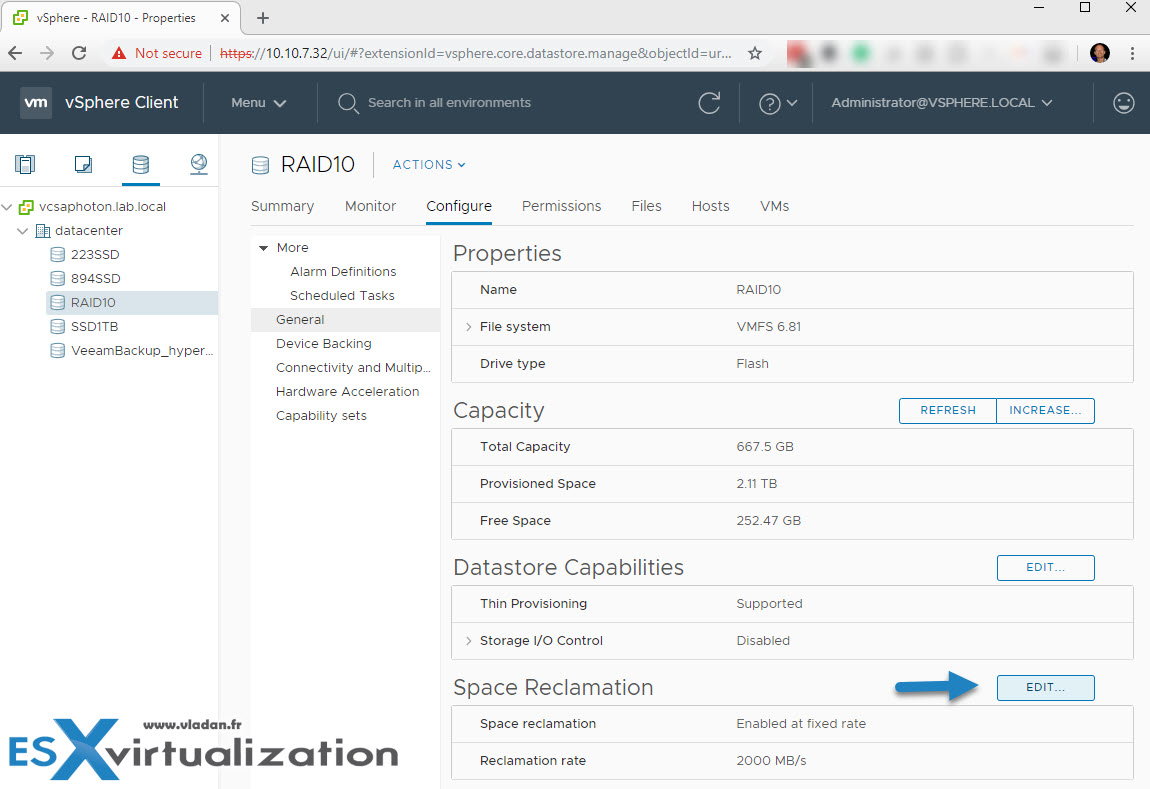

- VMWARE ESXI 5 RECLAIMING THIN PROVISIONED DISK UNUSED SPACE FULL
- VMWARE ESXI 5 RECLAIMING THIN PROVISIONED DISK UNUSED SPACE FREE
(This practice is called "overprovisioning" – we assign virtual disks more space than they can physically take up. Each virtual machine has a thin-provisioned virtual disk set with a maximum size of 10 GB. For example, we have a 20GB datastore with three virtual machines running on it. Let’s consider an example that renders the virtual machines unusable.
VMWARE ESXI 5 RECLAIMING THIN PROVISIONED DISK UNUSED SPACE FREE
There are some issues that you should be aware of and prepared to deal with.ĭownload our free White Paper: "How to Calculate Recovery Time Objective and Cut Downtime Costs" Using thin-provisioned virtual disks is not always smooth. Issues That May Occur When Using Thin-Provisioned Virtual Disks
VMWARE ESXI 5 RECLAIMING THIN PROVISIONED DISK UNUSED SPACE FULL
If it were a full deletion, where zeroes were written over the blocks that the deleted files occupied, it would take about the same amount of time as copying the files in question.

This is why we see file removal as instant. This is because the operating system deletes only the indexes from the file table that refer to the file body in the file system it marks the blocks that belonged to "deleted" files as free and accessible for new data to be written onto. Note that when you delete your data from a thin-provisioned virtual disk, the disk size is not reduced automatically. The performance of a thin-provisioned disk is not higher than that of a lazy zeroed thick-provisioned disk, because for both of these disk types, zeroes have to be written before writing data to a new block. Thin-provisioned virtual disks are quick to create and useful for saving storage space. A thin-provisioned virtual disk consumes only the space that it needs initially, and grows with time according to demand.įor example, if you create a new thin-provisioned 30GB virtual disk and copy 10 GB of files to it, the size of the resulting VMDK file will be 10 GB, whereas you would have a 30GB VMDK file if you had chosen to use a thick-provisioned disk. Thin provisioning is another type of storage pre-allocation. If you create an eager zeroed virtual disk on this datastore, the disk area will be totally erased (i.e., zeroed), thus preventing anyone with bad intentions from being able to recover the previous data – even if they use specialized third-party software.ĭesigned for businesses of all sizes, NAKIVO Backup & Replication offers complete data protection for all of your production workloads, including VMware vSphere Backup, Hyper-V Backup, Microsoft 365 Backup and more. Why? When you delete a VMDK, the data on the datastore is not totally erased the blocks are simply marked as available, until the operating system overwrites them. This sub-type of thick-provisioned virtual disk supports clustering features, such as fault tolerance.įor data security reasons, eager zeroing is more common than lazy zeroing with thick-provisioned virtual disks. Creating eager zeroed disks takes longer, because zeroes are written to the entire disk, but their performance is faster during the first writes.


 0 kommentar(er)
0 kommentar(er)
